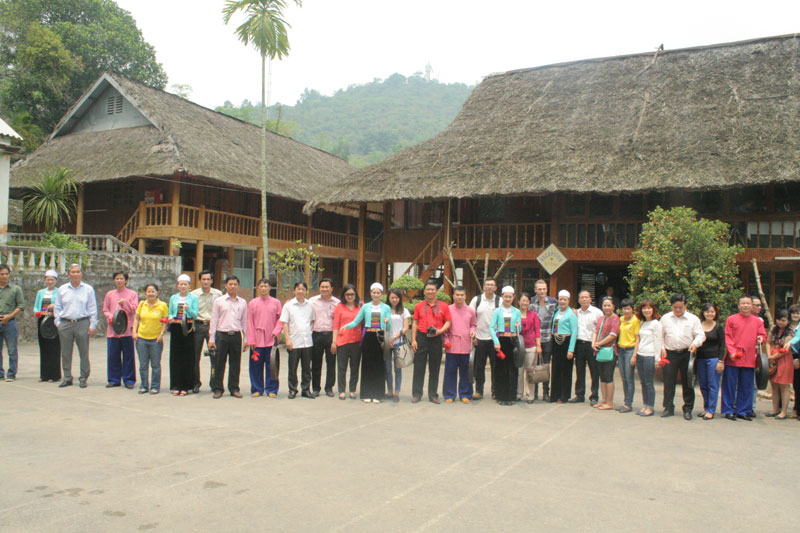
(HBO) – Famtrip, an abbreviation of familiarization trip, has become a familiar term in the tourism industry to talk about tours offered to travel agents by a supplier or group of suppliers to familiarize the agents with their destinations and services.
A plan is being developed to turn
Hoa
Binh
Lake into a national tourist zone that
sees a perfect combination of nature, sky and water, and pristine wildlife.
Some says the lake looks like a Ha Long Bay on the mountain with huge potential
to develop cultural and historical tours, eco-tours and spiritual tours.
State agencies and travel agencies have organized many
Famtrip to the lake in the hope that it would open new opportunities for
tourism development in the area.
The Hoa Binh Tourist JSC has invested in tourism
products based on the nature and culture of Muong ethnic minority people along
with tourism facilities in Ngoi village, Ngoi Hoa commune (Tan Lac district) and
a high-end tourism site in
Sung
Island, Tien Phong District.
The company has coordinated with other tour operators in
Vietnam, the
USand
Germanyand Tourism Authority of Thailand to organize Famtrips to its tourism routes in
Hoa Binh.
Four free famtrips have been held so far to survey the
potentials of and develop tours in
Ngoi
Village, Ngoi Hoa Commune
of Tan Lac District and Ba Khan Commune of Mai Chau District.
The company also invited reporters from prestigious
domestic and international media agencies on Presstrips to
Hoa
Binh
Lake.
The Famtrips and Presstrips aim to promote the beauty
of Hoa Binh and the company’s tourism products among domestic and international
visitors, said Director General of Hoa Binh Tourist Nguyen Thi Thuy Phuong.
In addition,
the company has attended tourism fairs in
Hanoi,
Ho Chi Minh City,
Germany, and events promoting
tourism links in an effort to attract more visitors to the lake.

Photo: Hoa Binh Tourism joint Stock Company
coordinates with travel and press agencies to survey and help promote tourism
products of Hoa Binh province.
On the part of
the province, the provincial authorities have coordinated with partners to conduct
a survey for developing a waterway travel route on Hoa Binh Lae and built plans
on cooperation with tourism departments of
Hanoiand
HCM
City.
The province has
worked with eight northwest mountainous provinces to build waterway tours in Da
River and partnered with the television channel of Radio The Voice of Vietnam (VOV
TV) to produce programme series for tourism promotion in the province.
Photo and writing contests have also been launched in
a bid to introduce the beauty of the province. The provincial tourism authority
also prepared marketing materials for its tourism partners./.
A diverse chain of eco-tourism and resort destinations concentrated in Hoa Binh city and the districts of Tan Lac, Da Bac, and Luong Son… Along with the launch of several key high-quality resort tourism projects, these developments have reshaped the landscape and enhanced the appeal of Hoa Binh as a travel destination.
Boasting diverse terrain, a mild climate, and rich natural resources, Cao Phong district is increasingly asserting its place on Vietnam’s tourism map, attracting both domestic and foreign visitors. The district is renowned for its stunning landscapes, majestic mountains, a crystal-clear hydropower lake, and the unique cultural identity of local ethnic groups.
With its pristine landscapes, unique cultural heritage of Muong ethnic minority, and an expanding range of visitor experiences, Tan Lac district of Hoa Binh has fast become a captivating destination for both domestic and international tourists.
Until now, Sung village in Cao Son commune, Da Bac district remains the only Dao ethnic community in Hoa Binh province to develop a community-based tourism model. Beyond its untouched natural landscapes, cultural identity serves as the cornerstone attraction for visitors.
Alongside the diverse cultural identities of the Kinh, Muong, Tay, Thai, Dao, and Mong ethnic people, Hoa Binh province is also renowned as the "capital" of the northwestern Vietnamese cuisine, offering unique and distinctive dishes. At festivals, during Lunar New Year (Tet), or on significant family or community occasions, special dishes are prepared, leaving a lasting impression on visitors.
A Phong Linh (Yellow Tabebuia) flower garden in Thang village, Thach Yen commune, Cao Phong district is currently in full bloom, drawing a large number of visitors.



